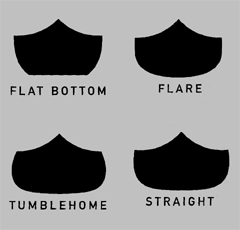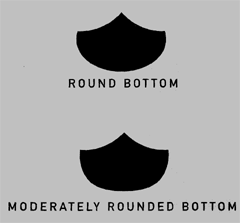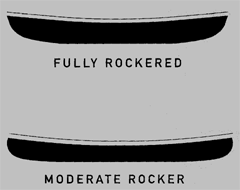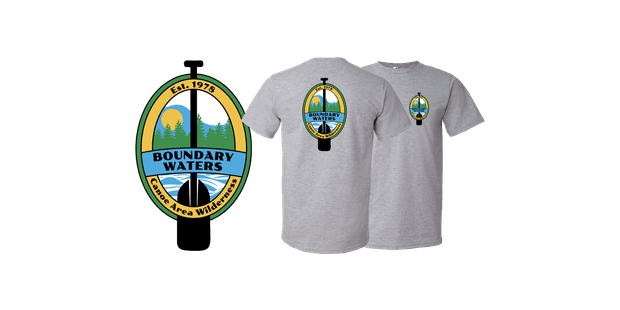Choosing the Right Canoe - Shape Matters

When it comes to canoes, it's important that the shape suits the use. Learn how hull shape, rocker, and bow shape can help you select the right shaped canoe for you.
Hull Shape
The flatter the bottom, the more primary stability (steady when flat) the canoe has, but you give up some hull speed. The more rounded the bottom, the less initial stability but the swifter the hull. Flat-bottomed hulls are used in sport and cottage-type canoe hulls because their stability makes them good for fishing and for novice paddlers. A moderately rounded bottom is more maneuverable and capable of better speed; it is used in touring and expedition canoe hulls.

Lake canoes should have a keel or v-bottom to help the canoe track and river canoes should not have a keel, for maneuverability. Tumblehome (the width between the gunwales is less than the overall width of the canoe) allows the canoe to be paddled without giving up hull displacement — which determines weight-carrying capacity (burden). The greater the displacement, the greater the carrying capacity. Tumblehome is often achieved in whitewater playboats by using a gunwale tuck (a method of molding materials such as Royalex to create tumblehome).

Secondary stability (the canoe gains stability as it is heeled over) is created by flaring the sides of the midsections. This allows the paddler to heel the canoe over to carve turns — which is important for whitewater boats. Tumblehome is also found in some recreational hulls.
~Get the BWCAW Tee~
With over 1,090,000 acres of wilderness area, the BWCAW is a paddler's paradise.
Rocker
Rocker is the amount the hull curves from bow to stern. Rocker slows hull speed and decreases the accommodation of large payloads. Lake and touring canoes should have conservative amounts of rocker to increase hull speed. It is not critical for river hulls to be fast but it is important that they have rocker for maneuverability (5 – 6" is good for a 16-foot whitewater canoe).Touring and expedition canoes should have some rocker as well (2" is good for a l6- or l7-foot canoe). When choosing a touring, expedition, or sport canoe that will be paddled tandem and solo, look for a symmetrical hull (the shape of the canoe is identical fore and aft).

Bow Shape
The bow is what cleaves the water, so it is important that the shape suits the use. Whitewater boats need high volume bows and sterns for buoyancy — assuring their ability to go over large waves and giving the canoe more buoyancy over shorter lengths. More rounded ends in whitewater playboats make it easier to change direction in upstream maneuvers as well. Touring and expedition canoe hulls need to take lake waves (and moderate whitewater) and still have good hull speed. This is achieved by shaping the bow and stern with a slight flare to direct water away. The bow and stern should have low enough volume, however, to cleave waves easily
Douglas Wipper, a former director of the National Canoeing Schools of Canada, is the director of the Steamboat Springs Canoeing School in Steamboat Springs, Colorado. He has instructed canoeing for universities and private camps for more than 30 years.
Related Articles
These are the best canoes of 2024. Credit: girlseeingworld The best canoes of 2024 may not be what…
Ken Whiting answers the big question for new paddlers - Do you go for a canoe, a kayak, or a stand up…
First, a moment of silence for the hardest working man in show business. The Godfather of soul - James…
I have been to a number of kayaking events over the last three months where numerous kayaks have been…



